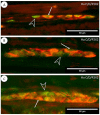Immunodetection of P2X2 Receptor in Enteric Nervous System Neurons of the Small Intestine of Pigs
- PMID: 36552495
- PMCID: PMC9774495
- DOI: 10.3390/ani12243576
Immunodetection of P2X2 Receptor in Enteric Nervous System Neurons of the Small Intestine of Pigs
Abstract
Extracellular adenosine 5'-triphosphate (ATP) is one of the best-known and frequently studied neurotransmitters. Its broad spectrum of biological activity is conditioned by the activation of purinergic receptors, including the P2X2 receptor. The P2X2 receptor is present in the central and peripheral nervous system of many species, including laboratory animals, domestic animals, and primates. However, the distribution of the P2X2 receptor in the nervous system of the domestic pig, a species increasingly used as an experimental model, is as yet unknown. Therefore, this study aimed to determine the presence of the P2X2 receptor in the neurons of the enteric nervous system (ENS) of the pig small intestine (duodenum, jejunum, and ileum) by the immunofluorescence method. In addition, the chemical code of P2X2-immunoreactive (IR) ENS neurons of the porcine small intestine was analysed by determining the coexistence of selected neuropeptides, i.e., vasoactive intestinal polypeptide (VIP), substance P (sP), and galanin. P2X2-IR neurons were present in the myenteric plexus (MP), outer submucosal plexus (OSP), and inner submucosal plexus (ISP) of all sections of the small intestine (duodenum, jejunum, and ileum). From 44.78 ± 2.24% (duodenum) to 63.74 ± 2.67% (ileum) of MP neurons were P2X2-IR. The corresponding ranges in the OSP ranged from 44.84 ± 1.43% (in the duodenum) to 53.53 ± 1.21% (in the jejunum), and in the ISP, from 53.10 ± 0.97% (duodenum) to 60.57 ± 2.24% (ileum). Immunofluorescence staining revealed the presence of P2X2-IR/galanin-IR and P2X2-IR/VIP-IR neurons in the MP, OSP, and ISP of the sections of the small intestine. The presence of sP was not detected in the P2X2-IR neurons of any ganglia tested in the ENS. Our results indicate for the first time that the P2X2 receptor is present in the MP, ISP, and OSP neurons of all small intestinal segments in pigs, which may suggest that its activation influences the action of the small intestine. Moreover, there is a likely functional interaction between P2X2 receptors and galanin or VIP, but not sP, in the ENS of the porcine small intestine.
Keywords: P2X2; enteric nervous system; galanin; pig; small intestine; substance P; vasoactive intestinal polypeptide.
Conflict of interest statement
The authors declare no conflict of interest.
Figures





Similar articles
-
Morphology and Chemical Coding of Rat Duodenal Enteric Neurons following Prenatal Exposure to Fumonisins.Animals (Basel). 2022 Apr 19;12(9):1055. doi: 10.3390/ani12091055. Animals (Basel). 2022. PMID: 35565482 Free PMC article.
-
Immunolocalization of NOS, VIP, galanin and SP in the small intestine of suckling pigs treated with red kidney bean (Phaseolus vulgaris) lectin.Acta Histochem. 2013 Apr;115(3):219-25. doi: 10.1016/j.acthis.2012.06.010. Epub 2012 Jul 20. Acta Histochem. 2013. PMID: 22819292
-
Characterisation of cocaine- and amphetamine- regulated transcript-like immunoreactive (CART-LI) enteric neurons in the porcine small intestine.Acta Vet Hung. 2012 Sep;60(3):371-81. doi: 10.1556/AVet.2012.032. Acta Vet Hung. 2012. PMID: 22903082
-
Colorectal Cancer Invasion and Atrophy of the Enteric Nervous System: Potential Feedback and Impact on Cancer Progression.Int J Mol Sci. 2020 May 11;21(9):3391. doi: 10.3390/ijms21093391. Int J Mol Sci. 2020. PMID: 32403316 Free PMC article. Review.
-
Role and therapeutic target of P2X2/3 receptors in visceral pain.Neuropeptides. 2023 Oct;101:102355. doi: 10.1016/j.npep.2023.102355. Epub 2023 Jun 23. Neuropeptides. 2023. PMID: 37390743 Review.
References
-
- Kanjhan R., Housley G.D., Burton L.D., Christie D.L., Kippenberger A., Thorne P.R., Luo L., Ryan A.F. Distribution of the P2X2 Receptor Subunit of the ATP-Gated Ion Channels in the Rat Central Nervous System. J. Comp. Neurol. 1999;407:11–32. doi: 10.1002/(SICI)1096-9861(19990428)407:1<11::AID-CNE2>3.0.CO;2-R. - DOI - PubMed
LinkOut - more resources
Full Text Sources

